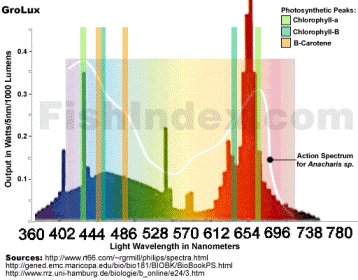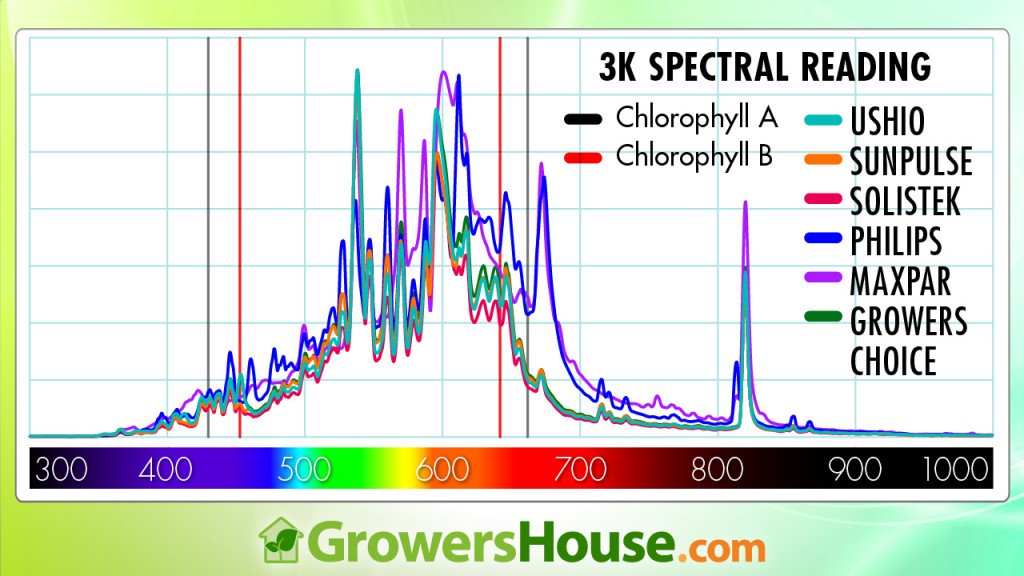Navigation
Install the app
How to install the app on iOS
Follow along with the video below to see how to install our site as a web app on your home screen.
Note: This feature may not be available in some browsers.
More options
You are using an out of date browser. It may not display this or other websites correctly.
You should upgrade or use an alternative browser.
You should upgrade or use an alternative browser.
A lot of led fixture question
- Thread starter me & my baby
- Start date
- Tagged users None
We had access to a 24" sphere - this was probably outside diameter. We tested these for our own purposes, so we used the spectrum that we think is valuable for acropora at 350 to 850nm - the visible 400-700 range is misleading at best and dangerous at worst and it provides no value when actually evaluating lamps to light acropora in the real world. We did test all-out without the range caps as the only other point of data - the Radion had about .5% more output out of this range (we have no idea where) and both the Phoenix and Radium had 2% more output over 850nm. There was just a small trace of either below 350, but the grad assistant said that this was not a good machine for UVB and UVC, so there could be a bit more there.
None of this has anything to do with quality, just output.
In all, 2.5 Radions at full power to equal the radiated watts of a 20K Radium on M80... no efficiency in output. This is what started my theory that if people were using 3x400W halides with 4x T5s and are now happy with 3x Radions or Kessils, then they probably never needed that much light in the first place and 3x 150W halides would have been enough. The best thing in the last decade of reefing is the realization that people do not need as much light as they thought, but this was discovered on accident with some mistruths about technological efficiency from manufacturers.
If we go again, I want to test a 10K for raw output and "waste" over 850, probably a 6500K and also try and figure out the wasted peak energy in some diodes - they can cut output vertically and horizontally. I really want to test a Orphek V4, but it will not fit either. Nearly every public university with a good Engineering School should have equipment like this - call or email one and see if they will let you use it. I used the one at my alma mater, so they were happy to help (even though they had no idea that I ever went there until we showed up) - they got geeked up about it a bit. They had a grad student help us (required) and a few more showed up to see what was happening. We took our lights, two kill-a-watts for more test points (they were identical, amazingly) and a tablet and pen/paper to write stuff down.
I hate it when people say that "photons are photons." Can anybody on this board effectively describe all of the elements of a quantum without looking it up? I only had three classes and I only know the very basics, but do know that a generalization such as this is infinitely more inaccurate than even comparing all corals equal to each other with the statement of "corals are corals." Other than electrical waste, which all products have in about equal amounts, the rest of the energy enters the quantum. Nearly all, if not all, are in photons, so in some way, shape or form, they are all produce the same quantity of output relative to input. The heat in MH is in the form of IR, not really mechanical loss - but LEDs and T5s get hot too for the same reasons about equally in mechanical loss, but much less in IR output. There is some IR that is pure waste above 850nm, but what we measured at 2% is OK with me, but it is real loss... this was about the same as the power supply loss for the G3 Radion and Kessil. The rest of the heat below 850nm is important to me since I truly believe that IR helps my acropora to grow faster and process energy better - something that Dana Riddle confirmed with a study that he posted on a few other threads. Quantum are like snowflakes and there could be a decade of debate and research (probably without any consensus) to figure out if it is possible for the exact same source to ever produce two identical real-life quantum, so this statement always irks me. The statement uttered a long time ago that I heard was "a photon will not care how it was created" that morphed into "a photon is a photon" which them somehow got construed that "all photons are equal." What is in the photon matters. If indeed a good photon is created, then it does not matter how it was.
None of this has anything to do with quality, just output.
In all, 2.5 Radions at full power to equal the radiated watts of a 20K Radium on M80... no efficiency in output. This is what started my theory that if people were using 3x400W halides with 4x T5s and are now happy with 3x Radions or Kessils, then they probably never needed that much light in the first place and 3x 150W halides would have been enough. The best thing in the last decade of reefing is the realization that people do not need as much light as they thought, but this was discovered on accident with some mistruths about technological efficiency from manufacturers.
If we go again, I want to test a 10K for raw output and "waste" over 850, probably a 6500K and also try and figure out the wasted peak energy in some diodes - they can cut output vertically and horizontally. I really want to test a Orphek V4, but it will not fit either. Nearly every public university with a good Engineering School should have equipment like this - call or email one and see if they will let you use it. I used the one at my alma mater, so they were happy to help (even though they had no idea that I ever went there until we showed up) - they got geeked up about it a bit. They had a grad student help us (required) and a few more showed up to see what was happening. We took our lights, two kill-a-watts for more test points (they were identical, amazingly) and a tablet and pen/paper to write stuff down.
I hate it when people say that "photons are photons." Can anybody on this board effectively describe all of the elements of a quantum without looking it up? I only had three classes and I only know the very basics, but do know that a generalization such as this is infinitely more inaccurate than even comparing all corals equal to each other with the statement of "corals are corals." Other than electrical waste, which all products have in about equal amounts, the rest of the energy enters the quantum. Nearly all, if not all, are in photons, so in some way, shape or form, they are all produce the same quantity of output relative to input. The heat in MH is in the form of IR, not really mechanical loss - but LEDs and T5s get hot too for the same reasons about equally in mechanical loss, but much less in IR output. There is some IR that is pure waste above 850nm, but what we measured at 2% is OK with me, but it is real loss... this was about the same as the power supply loss for the G3 Radion and Kessil. The rest of the heat below 850nm is important to me since I truly believe that IR helps my acropora to grow faster and process energy better - something that Dana Riddle confirmed with a study that he posted on a few other threads. Quantum are like snowflakes and there could be a decade of debate and research (probably without any consensus) to figure out if it is possible for the exact same source to ever produce two identical real-life quantum, so this statement always irks me. The statement uttered a long time ago that I heard was "a photon will not care how it was created" that morphed into "a photon is a photon" which them somehow got construed that "all photons are equal." What is in the photon matters. If indeed a good photon is created, then it does not matter how it was.
- Joined
- Sep 18, 2017
- Messages
- 5,610
- Reaction score
- 3,451
Photons are photons.. When all wavelengths between 2 light is equal.. Better?
1000 photons of 660nm generated by an LED are equal to 1000 photons of 660nm generated from a MH/T something.
Now, on the quantum level that "may" prove inaccurate but not seeing it ATM
How they are directed makes the most difference..
AFAICT few implied 1000 photons of 550nm light is equal to 1000 photons 420nm light for a specific purpose "photosynthesis"
That would be bad..
Thanks for the clarification.. Still curious as to specific bandwidth percents. Was hoping you had it at your finger tips..Spreadsheet style.
You may hate "photons are photons" but I I hate "reinventing the wheel"...
I'm barely grasping Mr. Riddle's study concluding that, basically, and to put it more in laymans terms.. high nm red can purge one photosystem and free up precursors to allow it to continue to function effectively..and increase available energy..
My "issue" w/ that is this would have to be when the first ps saturates......so a specific case..
Not commiting to it one way or another.
Again, thanks.
1000 photons of 660nm generated by an LED are equal to 1000 photons of 660nm generated from a MH/T something.
Now, on the quantum level that "may" prove inaccurate but not seeing it ATM
Where E is photon energy, h is the Planck constant, c is the speed of light in vacuum and λ is the photon's wavelength. As h and c are both constants, photon energy changes with direct relation to wavelength λ
How they are directed makes the most difference..
AFAICT few implied 1000 photons of 550nm light is equal to 1000 photons 420nm light for a specific purpose "photosynthesis"
That would be bad..
Thanks for the clarification.. Still curious as to specific bandwidth percents. Was hoping you had it at your finger tips..Spreadsheet style.
You may hate "photons are photons" but I I hate "reinventing the wheel"...
I'm barely grasping Mr. Riddle's study concluding that, basically, and to put it more in laymans terms.. high nm red can purge one photosystem and free up precursors to allow it to continue to function effectively..and increase available energy..
My "issue" w/ that is this would have to be when the first ps saturates......so a specific case..
Not commiting to it one way or another.
Again, thanks.
IR can allow the coral to use and process more energy, which is necessary in nature when IR is present. People who have used low K, high intensity lights know this by experience - these were once the lights of choice when we had no others. Although I don't miss, nor use them anymore, growth was exceptionally better under them. Think about it... corals in the ocean under less than 1M of water grow at a massive rate, but are exposed to nearly all wavelengths of the sun since the water is not deep enough filter out much, if anything. As they get deeper, the IR gets filtered and growth slows (the assumption, but output is also cut, so not a perfect assumption). When we were in the Coral Sea, the acropora collected was done mostly in waist high water and with snorkels and masks... 3M at the max and most much shallower... some were cutting the acros when they were exposed in the open air.
I can put a 400W 6500K Halide over my tank and the corals will respond and grow MUCH faster. Corals outside in the sun one summer had exceptional growth. Output is one factor, for sure. ...but the source of output matters. This same output from a LED will burn and kill the coral. There are two reasons for this, IMO... none of which have much proof, but based loosely in other studies, conversations and experiences 1). there are some waves peaks that are too high in some white diodes that are harmful to coral in high quantities, and 2). no IR.
I think that oversimplifying quantum mechanics is dangerous academically - which is all that this is. In practice no photon is the same as another. The collection of photons is what matters, not a single photon. I have also heard people say that there are "no magic photons" in an attempt to look smart and belittle people with a strawman, but this is also irksome. While this is true, there are collections of them that are better than others, so while not "magic," they might seem so to people who will believe that "photons are photons." I guess that on a reef board, none of this matters since it will just repeated as rhetoric anyway without any real academic value... and I also accept that nobody cares that I am irritated by it.
This is the most thriving example of our hobby... and it appears to use every ounce of energy that it can get and is not damaged by any of it (not my photo):
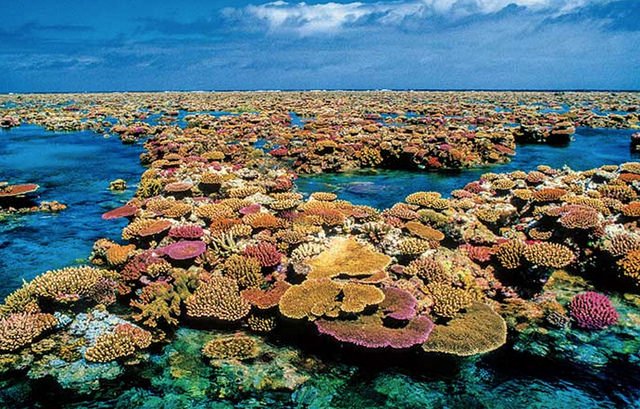
I can put a 400W 6500K Halide over my tank and the corals will respond and grow MUCH faster. Corals outside in the sun one summer had exceptional growth. Output is one factor, for sure. ...but the source of output matters. This same output from a LED will burn and kill the coral. There are two reasons for this, IMO... none of which have much proof, but based loosely in other studies, conversations and experiences 1). there are some waves peaks that are too high in some white diodes that are harmful to coral in high quantities, and 2). no IR.
I think that oversimplifying quantum mechanics is dangerous academically - which is all that this is. In practice no photon is the same as another. The collection of photons is what matters, not a single photon. I have also heard people say that there are "no magic photons" in an attempt to look smart and belittle people with a strawman, but this is also irksome. While this is true, there are collections of them that are better than others, so while not "magic," they might seem so to people who will believe that "photons are photons." I guess that on a reef board, none of this matters since it will just repeated as rhetoric anyway without any real academic value... and I also accept that nobody cares that I am irritated by it.
This is the most thriving example of our hobby... and it appears to use every ounce of energy that it can get and is not damaged by any of it (not my photo):

- Joined
- Sep 18, 2017
- Messages
- 5,610
- Reaction score
- 3,451
"no magic photons" applied more to the Kessil marketing that insists PAR meters don't really define their output which is mostly BS.. 
Also those that insist MH produce "magic photons" when it is just a matter of wavelength and quantity (and directionality).
There may be something but it isn't magical.. thus the sarcasm..
Much if the incident sunlight is "directional" ..see the harsh shadows. More LED than T5..
You are referring to bandwidth differences not one "pack" of 660nm red photons from the sun are inherently "different" than the same amount from an LED (or ANY source)..
and as to using 6500k.. well 100% agree w/ you..just not "popular" anymore..
gee a "fuller" spectrum produces good results..
SOURCE doesn't matter...Only quality (content) and quantity..
Showing corals that have produced tons of protective pigments is proof of nothing really..except for the effects of various components that may, or may not be , present in artificial lighting.
Even arguing smoothness of spectrum is just "quality and quantity"..
feel free to show me somewhere where sunlight photons exist in a different (well think you might know what I mean) quantum state than one originating from an LED AND creates differential capture of said photon, I'll buy your "assumption"..
as it stands you are guessing as much as I am..
Also those that insist MH produce "magic photons" when it is just a matter of wavelength and quantity (and directionality).
There may be something but it isn't magical.. thus the sarcasm..
Much if the incident sunlight is "directional" ..see the harsh shadows. More LED than T5..
.Output is one factor, for sure. ...but the source of output matters.
You are referring to bandwidth differences not one "pack" of 660nm red photons from the sun are inherently "different" than the same amount from an LED (or ANY source)..
and as to using 6500k.. well 100% agree w/ you..just not "popular" anymore..
gee a "fuller" spectrum produces good results..
SOURCE doesn't matter...Only quality (content) and quantity..
Showing corals that have produced tons of protective pigments is proof of nothing really..except for the effects of various components that may, or may not be , present in artificial lighting.
Even arguing smoothness of spectrum is just "quality and quantity"..
feel free to show me somewhere where sunlight photons exist in a different (well think you might know what I mean) quantum state than one originating from an LED AND creates differential capture of said photon, I'll buy your "assumption"..
as it stands you are guessing as much as I am..
Last edited:
- Joined
- May 22, 2016
- Messages
- 568
- Reaction score
- 457
"no magic photons" applied more to the Kessil marketing that insists PAR meters don't really define their output which is mostly BS..
Also those that insist MH produce "magic photons" when it is just a matter of wavelength and quantity (and directionality).
There may be something but it isn't magical.. thus the sarcasm..
Much if the incident sunlight is "directional" ..see the harsh shadows. More LED than T5..
.
You are referring to bandwidth differences not one "pack" of 660nm red photons from the sun are inherently "different" than the same amount from an LED (or ANY source)..
and as to using 6500k.. well 100% agree w/ you..just not "popular" anymore..
SOURCE doesn't matter...Only quality (content) and quantity..
After many years, I still don’t get the lighting. How much it too much? How to bring the light up slowly. Moving corals to different tank levels. Not giving new corals too much light. Not giving corals enough light. One time I put 2 x 52 w T5 10k and 2 52w T5 actinic over my 60 gallon tank. I practically had to wear sun glasses or squint to look at it. After my wife’s complaints, which seemed pretty reasonable, I reduced the lighting to 2 tubes total. If you use plenty of light, and don’t get results, the first suggestion is to reduce the lighting. When you are looking to purchase lighting, you are told that nothing short of extreme will get the job done for LPS and especially SPS. The next thing you know, your corals are burning from too much light.
I have had my best results when the lighting is less than optimal, then when I’m sure I’m doing the max.
- Joined
- Jan 3, 2018
- Messages
- 834
- Reaction score
- 699
Who on this planet can claim to understand light? Statements such as "photons are photons" illustrate the hubris of man more than anything else. If we are honest, we have to admit that we know almost nothing about light. Photons (if they exist at all) are supposedly particles with no mass, but can be bent by gravity, and yet some how exhibit wave properties. The speed of light is also constant with respect to all reference frames (try to wrap your mind around that). Statements such as "corals do not need X, or only use Y also display an amazing arrogance, as they can never be proven. I suspect they use everything to some degree. Not to discourage research, but in the end all we really have is our experience that says this lighting system works well or does not, regardless of how many charts and tables we can find on the internet or in our textbooks to support our prejudices.
- Joined
- Sep 18, 2017
- Messages
- 5,610
- Reaction score
- 3,451
1=1... photons =photons.. Nothing wrong w/ that. Never said a 400nm photon was equal to a 700nm photon. THAT would be stupid.. 
I know it is a generalization for effect..but it's kind of fun..
I said a 400nm photon, regardless of it's origin is a 400nm photon.. just identity..I'll leave some room for doubt.. but ....
What you imply leaves ZERO room for any study/advancement. Why use LED's to study the effects on coral if there is no continuity of concept?
No, I'm not going to pretend I understand all of that.. but I am also not going to say they don't understand it or it is wrong.. THAT is Hubris..
AND if you can show me one statement where I said "corals don't need..." I will walk it back..
Without some hubris we'd be static...Like anything, just a matter of degrees...or "quantity" and directionality..
"You people" are taking this waaay to seriously..and quite negatively..
We probably know more about physics than living things and their interactions w/ physics..but you are right.. seems like the proverbial tip of the iceberg for both..
WAY off any topic though.. more of a philosophy discussion.
for both of us..
https://physics.stackexchange.com/questions/273032/what-exactly-is-a-photon
I know it is a generalization for effect..but it's kind of fun..
I said a 400nm photon, regardless of it's origin is a 400nm photon.. just identity..I'll leave some room for doubt.. but ....
What you imply leaves ZERO room for any study/advancement. Why use LED's to study the effects on coral if there is no continuity of concept?
Below is an extract from the manuscript titled “The Singularities and the Space Particles (SP) Theory- The fundamental structure of subatomic particles) which has just been submitted to the International Journal for Theoretical Physics by the author (Mahmoud Nafousi).
Photons with various energy levels, hence the law E=h*f where E is the energy, h is the Planck constant (or a single string of energy) and f is frequency (i.e. the number of strings in the photon).
So the various frequencies of any photons are determined by the number of the E Quanta linked/ joined in a chain like structure. This explains why all Photons of different frequencies/ vibrations travel at the constant speed of light.
The greater the number of the E quanta in a photon the more squeezed they are within that photon leading to its greater vibration/ shorter frequency. The photon has a spin of 1 and it is theorised to be its own antiparticle. This would imply that the photons are made of a chain of double E strings made of R-L and L-R helicity.
Different clusters of E quanta (with their rotational/ orbital angular momentum) form the various energy clouds of all the Fermion and other subatomic particles. The vibrating and flexible fabric of space is also made of the E quanta
No, I'm not going to pretend I understand all of that.. but I am also not going to say they don't understand it or it is wrong.. THAT is Hubris..
AND if you can show me one statement where I said "corals don't need..." I will walk it back..
Without some hubris we'd be static...Like anything, just a matter of degrees...or "quantity" and directionality..
"You people" are taking this waaay to seriously..and quite negatively..
We probably know more about physics than living things and their interactions w/ physics..but you are right.. seems like the proverbial tip of the iceberg for both..
WAY off any topic though.. more of a philosophy discussion.
for both of us..
https://physics.stackexchange.com/questions/273032/what-exactly-is-a-photon
- Joined
- Feb 15, 2012
- Messages
- 4,735
- Reaction score
- 3,412
Do you know what would be the difference between "infra red" and "thermo infra red" in the spectrum?The UV degradation plays a huge part, but then so does the heat once the plastic is degraded. The plastic gets damaged over time and then it is impacted more by the heat. Tanks that are stored outside in the sun also have this issue, only much faster. Acrylic, especially cheaper grades, can get serious damaged by this as well. The typical story is that a tank would be fine for years and then all of a sudden, this would happen... the lights did not change, but the plastic did over time. If it was just heat, then it would be almost instant since most bulbs burn more hot with more output when they are being broken in and are brand new.
Just with fans, my plastic trim is not even 100 degrees, but that is enough if the plastic is compromised. I only run 250W HQI though, which are not quite as hot as 400s, but significantly more hot than 250s on M58 or electronic.
This was a larger issue for SE bulbs since DE have a larger glass shield, but DE would still have this happen. It was a HUGE issue for folks who shined a bulb directly over a brace since it got a lot more waves than off to the side.
This is why Oceanic claimed to make their braces out of glass.
Even without the heat, the plastic will eventually get crumbly and brittle with lots of UV exposure... the cheaper the tank, the worse off. Then, the pressure of thin glass panels pressing apart could snap them. This could be a problem for LED folks as they start to introduce real UV and not BS/marketing violet and calling it UV.
Anybody with LEDs, please keep in mind that even though your manufacturer might call stuff UV, spectrum over 400nm is just violet and not a danger. Real UV of danger will be 350, 360, 370 and 380 chips, which are not all that common in most fixtures yet, but are being added more and more. These are important to the coral, so they are worth having... just keep an eye on the plastic stuff and order tanks with glass or metal braces if you are worried.
Grandis.
- Joined
- Feb 15, 2012
- Messages
- 4,735
- Reaction score
- 3,412
I would like to know the source of the graphic, if possible.
Red area is the PAR range. Most LED's will have little or nothing beyond the red lines
Blue is "extended" PAR range..
Curious as to the % energy in those defined ranges..well IR to 850..sadly chart only goes to 800
Ignoring the morphological and pigment changes for the moment.. and still just considering any growth enhancements past 725
In case you are misunderstanding me .. this is an honest request since you did raise a good, and overlooked point..
I'm interested to know what are those ballasts, specifically.
They should be all magnetic...
So, what would be the specifics of: "magnetic", "PFO HQI" and "Blue Line".
That would help us to view the graphic better. Specially if we knew the fixture/reflector too...
Grandis.
- Joined
- Sep 18, 2017
- Messages
- 5,610
- Reaction score
- 3,451
http://www.advancedaquarist.com/2008/10/review
most of my MH charts come from here.. Not the same as above but related..
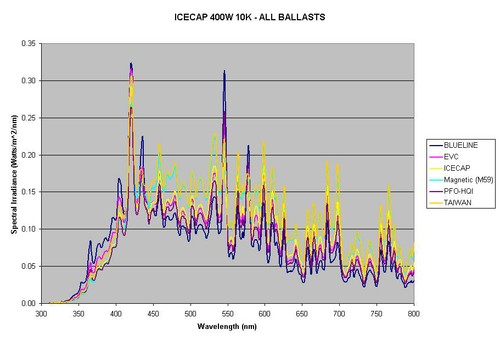
LWIR, IR-C DIN
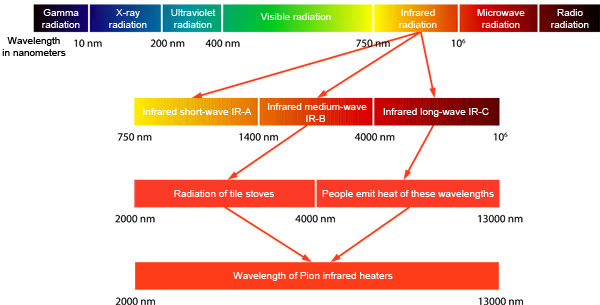
most of my MH charts come from here.. Not the same as above but related..

Do you know what would be the difference between "infra red" and "thermo infra red" in the spectrum?
Grandis.
LWIR, IR-C DIN
The "thermal imaging" region, in which sensors can obtain a completely passive image of objects only slightly higher in temperature than room temperature - for example, the human body - based on thermal emissions only and requiring no illumination such as the sun, moon, or infrared illuminator. This region is also called the "thermal infrared".

Grandis - you will be better off using the wavelength numbers and not the labels.
There is so much BS with names and labels, intentional and also unintentional, that this will be more clear. For example, 410nm is not ultraviolet to the rest of the world, but if you are selling Reef LEDs, then it is.
There is so much BS with names and labels, intentional and also unintentional, that this will be more clear. For example, 410nm is not ultraviolet to the rest of the world, but if you are selling Reef LEDs, then it is.
- Joined
- Feb 15, 2012
- Messages
- 4,735
- Reaction score
- 3,412
Thanks!http://www.advancedaquarist.com/2008/10/review
most of my MH charts come from here.. Not the same as above but related..

LWIR, IR-C DIN

Grandis.
- Joined
- Feb 15, 2012
- Messages
- 4,735
- Reaction score
- 3,412
I was actually thinking that the terms would have a relationship with numbers, scientifically speaking.Grandis - you will be better off using the wavelength numbers and not the labels.
There is so much BS with names and labels, intentional and also unintentional, that this will be more clear. For example, 410nm is not ultraviolet to the rest of the world, but if you are selling Reef LEDs, then it is.
Edit:
So terms, unless they aren't expressed with number, are really just like nicknames then.
And basically speaking, LEDs will never be able to have a true UV unit for aquarium applications, unless they make it out of glass in a special unit, or something... still won't even compare to MHs. It will definitely be so expensive that would be only for fashion people to use.
Grandis.
Last edited:
- Joined
- Sep 18, 2017
- Messages
- 5,610
- Reaction score
- 3,451
Huh? No.. there are plenty of true UV-a UV-B diodes..I was actually thinking that the terms would have a relationship with numbers, scientifically speaking.
So basically LEDs will never be able to have a true UV unit for aquarium applications, unless they make it out of glass in a special unit, or something... still won't even compare to MHs. It will definitely be so expensive that would be only for fashion people to use.
Grandis.
Even UV-C
https://www.ebay.com/i/201832362928?chn=ps
UV-A diodes are a bit problematic and need very specific lensing but not expensive.. well unreasonably expensive.
And there are plenty of short lived cheap ones..
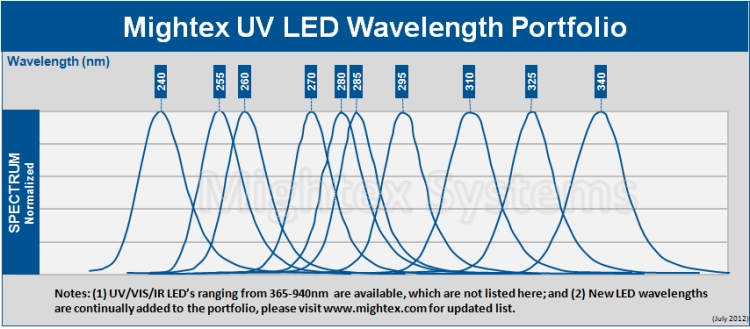
http://www.mightexsystems.com/images/Image/Mightex_UV_LED_wavelength_portfolio_July2012_750.jpg
I've learned to never say never..
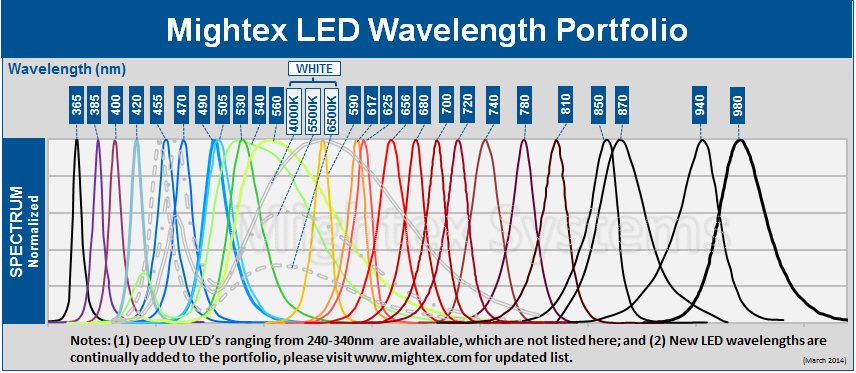
Lens material:
http://www.opticsforhire.com/blog/2016/4/21/best-materials-for-illumination-optics
quartz glass is still king..
https://www.lumitronix.com/en_gb/le...ia-ncsu276a-uv-smd-led-780mw-365nm-14340.html
Disclaimer:
Warning
Actinic UV danger for eyes and skin
Ultra violet radiation in the wavelength range of 200-400nm may cause inflammation of the cornea as well as a UV erythema (sunburn) of the skin. The biological effectiveness of the UV radiation varies in the stated wavelength range and is described with the spectral response function (weighting scale) SUV.
UV-A danger for the eyes
Ultra violet radiation in the wavelength range of 315-400nm (UV-A) is for the most part absorbed by the eye lens and may cause UV cataracts (clouding of the lens of the eye).
Last edited:
There are UV diodes. There are really three reasons why they are not widespread (yet).
1). They have been expensive in the past - this could have changed
2). They do not last very long - this also could have changed
3). Early iterations of aquarium LEDs have forsaken this spectrum and focused on the visible spectrum. The visible spectrum also would pop PAR meters and stuff to make their products look more powerful... people on this board cannot understand that LUX and PAR meters do not capture all of the usable output, so imagine what a time that AI or EcoTech would have telling people this.
There are some panels out now with real UV (not just 400 or 410nm labeled as UV), but I have not looked in a long while at what they lifecycle for them is. Most what I see is in the 380nm range, but no idea what kind it is, or anything. 360/365 would be a nice addition as well.
I imagine that every unit will have them soon. Without "upgrades" there is no reason to get rid of what you have.
This is one of the missing spectrum that a lot of people get back with T5s because nearly all have some UV, but some more than others.
1). They have been expensive in the past - this could have changed
2). They do not last very long - this also could have changed
3). Early iterations of aquarium LEDs have forsaken this spectrum and focused on the visible spectrum. The visible spectrum also would pop PAR meters and stuff to make their products look more powerful... people on this board cannot understand that LUX and PAR meters do not capture all of the usable output, so imagine what a time that AI or EcoTech would have telling people this.
There are some panels out now with real UV (not just 400 or 410nm labeled as UV), but I have not looked in a long while at what they lifecycle for them is. Most what I see is in the 380nm range, but no idea what kind it is, or anything. 360/365 would be a nice addition as well.
I imagine that every unit will have them soon. Without "upgrades" there is no reason to get rid of what you have.
This is one of the missing spectrum that a lot of people get back with T5s because nearly all have some UV, but some more than others.
Keep in mind that even though using LED is fairly new to most people in most cases, it is the oldest type of light in our hobby with the p-n junction being around since 1939. MH was not invented until the 1960s (I think). There are all kinds of rare-case diodes out there for specialty stuff. There are some for egg incubators, curing tooth filling cavity material, wart removal and all kinds of specialty stuff where the bandwidth needed to be kept narrow and the p-n junction was ideal. There are lots of diodes for lots of things - figuring out if/when they are applicable for us is the next step.
Fluorescent lighting is quite old too, but the "tube" iteration that we know is about fifty years old. That is right, LEDs are "old tech."
Fluorescent lighting is quite old too, but the "tube" iteration that we know is about fifty years old. That is right, LEDs are "old tech."
- Joined
- Sep 18, 2017
- Messages
- 5,610
- Reaction score
- 3,451
people on this board cannot understand that LUX and PAR meters do not capture all of the usable output..
That is a horribly broad brush and actually insulting...or should I say demonstrating Hubris...
You wouldn't even define the % of UV in your sphere..
Many "get it" MH's and to a lesser extent T5's ect. produce energy outside 400nm..(and outside 700nm..)
How much and what it actually means is more important..
Visible light is almost UNARGUABLY "the most" important part of the spectrum for most things..
Set up a tank w/ only UV or IR.. see how you like it..
UV "might" be fun..
advertising blurb for fun:
Unlike metal halide lamps, LEDs in the 400-700nm range that are used in aquarium fixtures do not emit UV radiation and that is one of the reasons Orphek now incorporates high range UV-A LEDs in their systems. The beauty of this is that unlike metal halide/HQI lamps, the UV-A output can be controlled thereby providing safe and beneficial levels for the corals while still bringing out the beautiful fluorescence of the corals. Orphek’s UV LEDs are in the range of 380-400nm which enters the visible range which produce a small amount of UV yielding a bluish purple light causing the corals to fluoresce while improving photosynthesis within the corals.
LED history for 10o Alex..
http://www.historyoflighting.net/light-bulb-history/history-of-led/
The same year they received patent for infrared LED. Nick Holonyak Jr., employed in General Electric, developed in 1962 first light-emitting diode that emitted light in the visible part of the frequency range. It was a red LED. In 1972, M. George Craford, who was a graduate student of Holonyak, invented the first yellow LED and a brighter red LED. Thomas P. Pearsall developed high brightness light-emitting diode in 1976, for use with fiber optics in telecommunications. Shuji Nakamura of Nichia Corporation made first blue LED in 1979 but it was too expensive for commercial use until 1994. Light emitting diodes can now be made in one or in more colors. At first Light-emitting diodes were very expensive, some US$200 per piece.
MH "started" in :
1912 Charles P. Steinmetz is the first to use halide salts in a mercury vapor lamp. He used the halides to correct color and was successful, but he could not get a consistent arc. The complex phenomena of plasma physics was still being explored. Steinmetz's arc would dance around allowing the temperature in the discharge tube to drop, the lower temperatures would stop the halide salts from burning and the color and intensity of the lamp would shift.
LED "started" in:
In 1907, British experimenter in Marconi labs Henry Joseph Round noticed for the first time that when a potential of 10volts is applied to carborundum (silicon carbide) crystal, it emits yellowish light.
Last edited:
- Joined
- Feb 15, 2012
- Messages
- 4,735
- Reaction score
- 3,412
Thanks for the post! Speaking of comparison to a halide system...Huh? No.. there are plenty of true UV-a UV-B diodes..
Even UV-C
https://www.ebay.com/i/201832362928?chn=ps
UV-A diodes are a bit problematic and need very specific lensing but not expensive.. well unreasonably expensive.
And there are plenty of short lived cheap ones..

http://www.mightexsystems.com/images/Image/Mightex_UV_LED_wavelength_portfolio_July2012_750.jpg
I've learned to never say never..

Lens material:
http://www.opticsforhire.com/blog/2016/4/21/best-materials-for-illumination-optics
quartz glass is still king..
https://www.lumitronix.com/en_gb/le...ia-ncsu276a-uv-smd-led-780mw-365nm-14340.html
Disclaimer:
But even if those were applied it would never reach the spread, uniformity and simplicity of using a good halide system with an efficient reflector.
It also wouldn't be financially worthy, to say the least, specially because of the need of changing the bulbs, optics, and so forth very often just to try them out and still not reach ska results of the halides... Besides, many LED users want to get away from changing bulbs, as we know.
Grandis.
- Joined
- Feb 15, 2012
- Messages
- 4,735
- Reaction score
- 3,412
I think that those who had experiences with T5s and halides see the missing part of the spectrum. I felt when I had my LED system here but didn't know exactly what it was. Specially because there was still a bit if heat coming from it. I'm beginning to understand better what really happens with those LED fixtures.There are UV diodes. There are really three reasons why they are not widespread (yet).
1). They have been expensive in the past - this could have changed
2). They do not last very long - this also could have changed
3). Early iterations of aquarium LEDs have forsaken this spectrum and focused on the visible spectrum. The visible spectrum also would pop PAR meters and stuff to make their products look more powerful... people on this board cannot understand that LUX and PAR meters do not capture all of the usable output, so imagine what a time that AI or EcoTech would have telling people this.
There are some panels out now with real UV (not just 400 or 410nm labeled as UV), but I have not looked in a long while at what they lifecycle for them is. Most what I see is in the 380nm range, but no idea what kind it is, or anything. 360/365 would be a nice addition as well.
I imagine that every unit will have them soon. Without "upgrades" there is no reason to get rid of what you have.
This is one of the missing spectrum that a lot of people get back with T5s because nearly all have some UV, but some more than others.
Grandis.
Similar threads
- Replies
- 41
- Views
- 865



